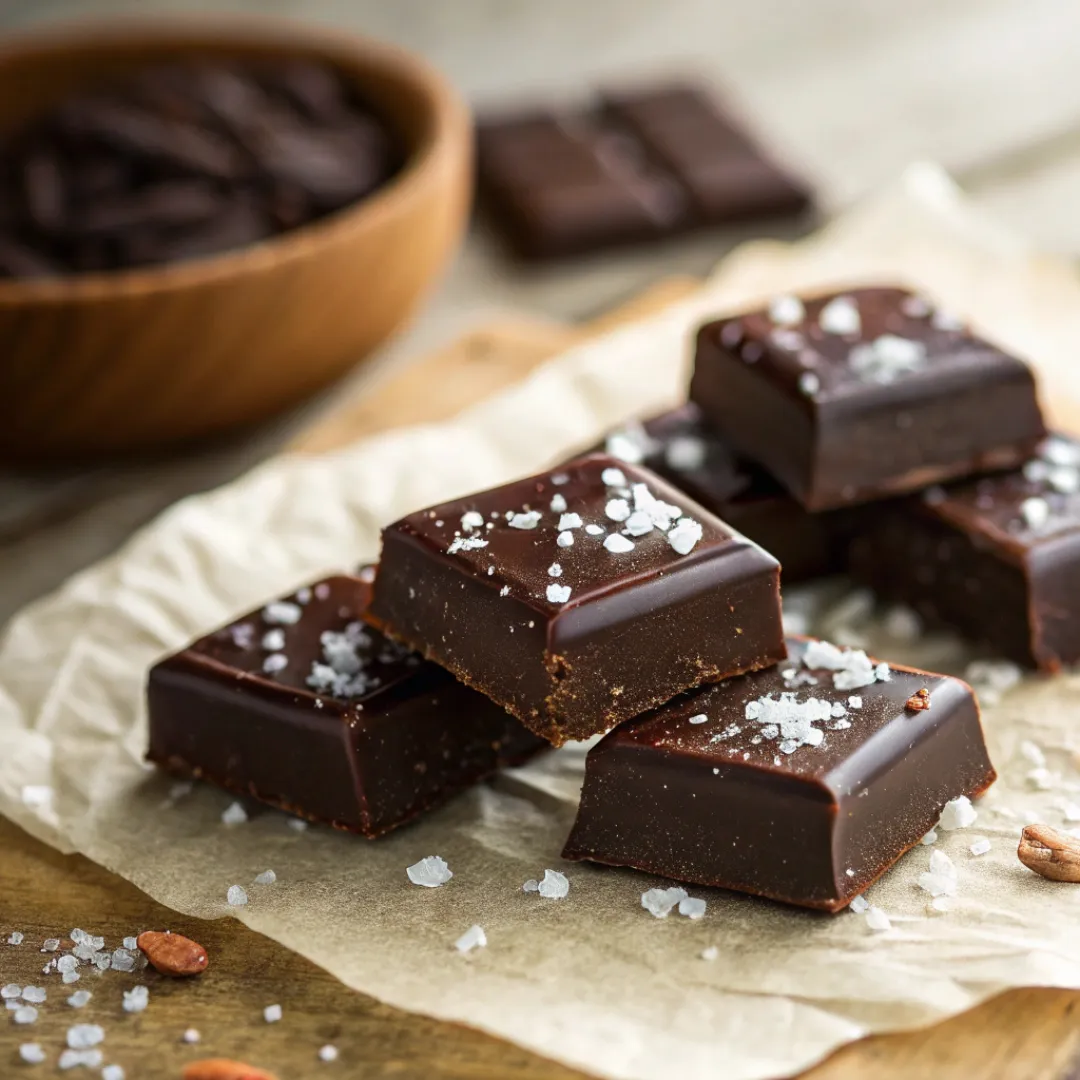Homemade dark chocolate is one of those rare desserts that manages to be both indulgent and nourishing—when prepared with care. With just a few clean, simple ingredients and no need for special tools, you can create healthy homemade dark chocolate in just minutes. In 2025, with grocery prices on the rise and food labels more confusing than ever, it’s no surprise that more people are turning to DIY homemade dark chocolate for clarity, quality, and control.
In this step-by-step guide, you’ll learn exactly how to make your own homemade dark chocolate using coconut oil, raw cacao powder (or cocoa), and a natural sweetener like honey or maple syrup. We’ll break down the benefits, explain the role of cacao percentages, explore how cost-effective it really is, and show you why this easy recipe might replace your go-to store-bought chocolate bar for good.
Looking for inspiration? Try our Chocolate Lasagna for another decadent dessert with a rich cocoa twist.
Why Homemade Dark Chocolate is Gaining Popularity
The Growing Demand for Clean, Homemade Treats
Today’s shoppers are more ingredient-aware than ever. They’re reading labels, questioning additives, and seeking out sustainable, whole-food options. That’s exactly why homemade dark chocolate is becoming a kitchen staple. With minimal effort, you get a cleaner, simpler treat—free of emulsifiers, preservatives, and mystery oils.
When you make dark chocolate at home, you skip the soy lecithin, artificial sweeteners, and palm oil found in many commercial brands. Instead, each bite of homemade dark chocolate can be tailored to fit paleo, keto, or vegan diets with ease.
Health-Conscious Reasons to Ditch Store-Bought Bars
Even so-called “healthy” dark chocolate bars often contain high amounts of sugar, processed dairy, or low-quality cocoa. With homemade dark chocolate, you control everything—from the cacao percentage and natural sweeteners (like raw honey or maple syrup) to whether or not you include dairy.
And the nutritional benefits are real—homemade dark chocolate made with raw cacao powder preserves more antioxidants, delivering a guilt-free, satisfying snack that’s actually good for you.
Want another clean-eating dessert? Try our Chocolate Banana Ice Cream for a wholesome way to satisfy chocolate cravings without compromise.
Why 2025 Is the Perfect Year to Make Your Own Dark Chocolate
With chocolate prices reaching all-time highs in 2025 and clean-label bars becoming more expensive (and harder to find), making your own dark chocolate isn’t just a trend—it’s a smart, empowering lifestyle shift. You get more value, better ingredients, and a deeper connection to what you’re eating.
Plus, it’s seriously fun. Whether you’re pouring homemade dark chocolate into silicone molds, making bark, or wrapping it up as gifts, you’ll enjoy a hands-on, creative process that delivers delicious results every time.
The Core Benefits of Homemade Dark Chocolate
Is Homemade Dark Chocolate Healthy?
Yes—homemade dark chocolate can be a healthier option, especially when made with wholesome, minimal ingredients. Unlike many store-bought bars loaded with preservatives, added sugars, and fillers, making it yourself lets you control exactly what goes in. You can choose raw cacao powder, a natural antioxidant powerhouse, and sweeten it with honey, maple syrup, or even monk fruit if you’re cutting back on sugar.
Plus, it’s naturally dairy-free, soy-free, and can be made vegan and paleo-friendly depending on your sweetener. Many homemade versions also skip refined sugars altogether, making them better for blood sugar and digestion.
Nutritional Comparison: Homemade vs Store-Bought Bars
Here’s a quick comparison to show how homemade dark chocolate stacks up:
| Feature | Store-Bought Bar | Homemade Dark Chocolate |
|---|---|---|
| Sugar Content | High (often added syrups) | Adjustable or natural only |
| Additives | Often includes lecithin, oils | None—just 3 ingredients |
| Antioxidant Level | Lower (due to processing) | Higher with raw cacao |
| Customization | None | Total control over ingredients |
| Cost per bar (2025 avg) | $4–$7 | Under $2 homemade |
Don’t miss our Frozen S’mores recipe for another smart way to satisfy your chocolate craving using real ingredients.
Antioxidants, Sugar Control, and Clean Ingredients
The secret weapon in homemade dark chocolate is cacao powder—rich in flavonoids, magnesium, and iron. These antioxidants support heart health, improve mood, and even lower inflammation. By controlling the sweetener, you can reduce overall sugar or even create low glycemic versions.
Here’s what you won’t find in your homemade batch: hydrogenated oils, corn syrup, waxy stabilizers, or preservatives. Instead, it’s just coconut oil, honey, and cacao—clean, simple, and loaded with benefits.
Ingredients Breakdown: What Goes Into Dark Chocolate
What Are the Ingredients Used to Make Dark Chocolate?
At its core, dark chocolate is surprisingly simple. To make a clean, rich, homemade version, you only need three essential ingredients:
- Coconut oil – acts as the fat base that binds everything together
- Raw cacao powder or unsweetened cocoa powder – the source of deep chocolate flavor and antioxidants
- Honey (or natural sweetener) – balances the bitterness of the cacao with natural sweetness
Add a pinch of sea salt, and you’ve got a balanced flavor profile without any artificial additives.
That’s it—no emulsifiers, no refined sugars, no dairy, and no mystery ingredients. Just real food.
Looking for natural dessert swaps? Check out our Carrot Cake Cookies for another better-for-you treat made from scratch.
Understanding Cocoa vs Cacao Powder
The terms cocoa powder and cacao powder are often used interchangeably, but they’re slightly different:
| Cocoa Powder | Cacao Powder |
|---|---|
| Roasted at high temps | Cold-processed/raw |
| Milder flavor | Stronger, more bitter |
| Fewer antioxidants | Rich in antioxidants |
| Common in baking | Popular in raw desserts |
For maximum health benefits, opt for 100% raw cacao powder, which retains more nutrients due to minimal processing. If you’re after a smoother, less intense flavor, unsweetened cocoa powder is still a good choice and more readily available.
Choosing the Best Coconut Oil and Sweeteners
Use virgin or unrefined coconut oil for a natural, slightly tropical undertone that complements dark chocolate beautifully. Refined coconut oil works too if you want a completely neutral flavor.
For sweeteners, raw honey is the classic choice in this recipe, offering subtle floral notes and natural enzymes. Prefer a vegan option? Go with maple syrup or agave. You can even try monk fruit or stevia for a sugar-free variation, though you’ll need to adjust ratios for consistency.
Each of these ingredients affects the texture, flavor, and nutritional profile, making homemade dark chocolate highly customizable.
Step-by-Step Recipe: How to Make Homemade Dark Chocolate
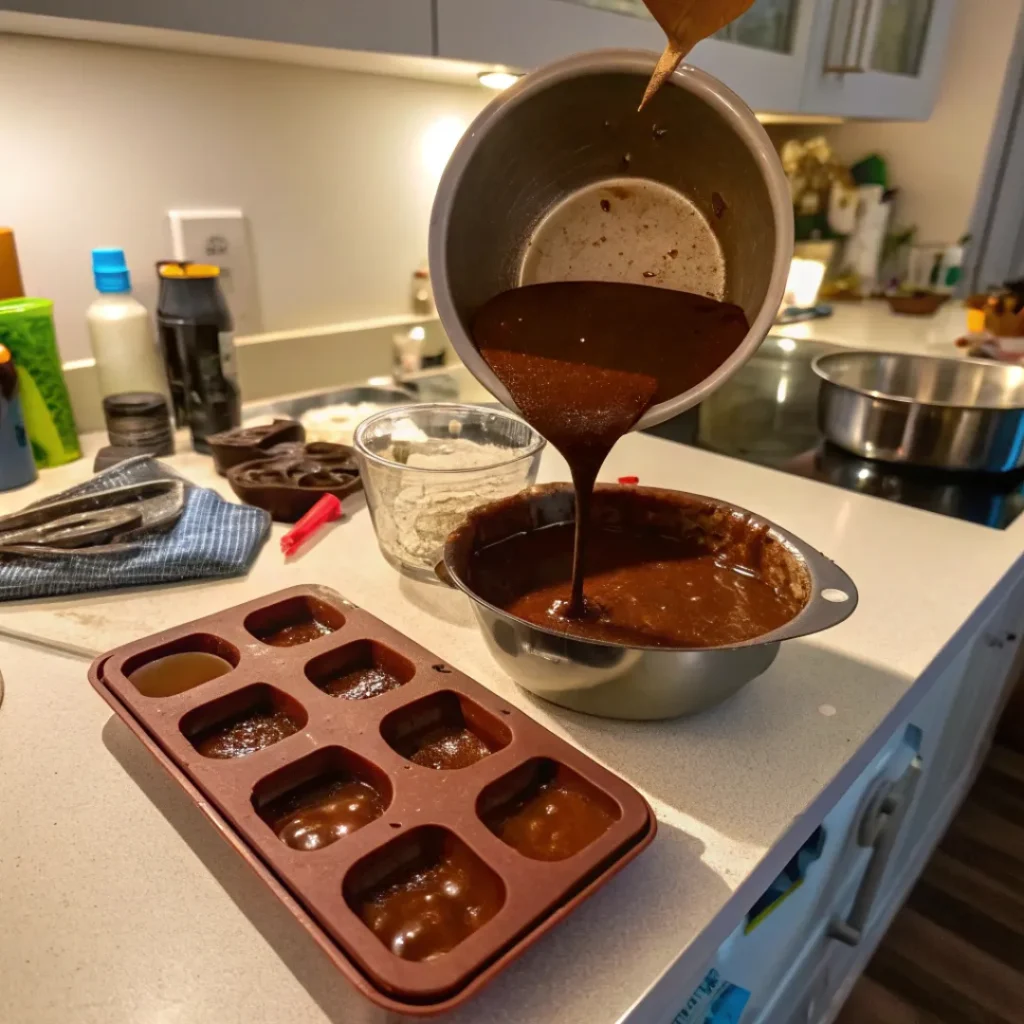
Equipment and Prep Tips
You don’t need any fancy tools to make this chocolate. Here’s what you’ll need:
- Small saucepan or pot
- Whisk or silicone spatula
- Measuring cups or kitchen scale
- Silicone molds or parchment-lined baking dish
- Refrigerator or cool room for setting
Tip: Have all ingredients pre-measured before you start—this recipe moves fast once the oil melts.
Melting, Mixing, and Pouring – Full Instructions
Here’s how to make rich, silky homemade dark chocolate in under 10 minutes:
Ingredients:
- ½ cup coconut oil (105g)
- 4 tbsp honey (or more, to taste – about 85g)
- 1 pinch sea salt
- 1 cup 100% unsweetened cocoa powder or raw cacao powder (118g)
Instructions:
- Melt the coconut oil in a small pot over low heat. Do not let it boil—just melt it gently.
- Remove from heat and stir in the honey and sea salt until fully dissolved.
- Add the cocoa powder and whisk until completely smooth and lump-free. The mixture should turn into a glossy chocolate sauce.
- Pour into silicone molds or a lined baking pan.
- Let cool at room temperature or refrigerate until fully hardened. Once solid, remove from molds or cut into pieces and enjoy!
That’s it—no tempering, no sugar overload, no fuss.
Want more easy chocolate ideas? Don’t miss our Chocolate Banana Ice Cream—a refreshing companion to homemade chocolate bites.
Cooling, Setting, and Storage Tips
- For a quick set, place your filled molds in the refrigerator for 20–30 minutes.
- Once firm, transfer chocolates to an airtight container and store in a cool, dry place or the fridge.
- Because coconut oil melts easily, avoid direct sunlight or warm temperatures.
Your homemade chocolate will keep for up to 2 weeks refrigerated—but it rarely lasts that long!
How 70% Dark Chocolate is Made
How Is 70% Homemade Dark Chocolate Made?
When you see a bar labeled “70% dark chocolate,” it means 70% of its weight comes from cacao ingredients—typically a mix of cocoa mass, cocoa butter, and/or cocoa powder. The remaining 30% usually includes sugar, vanilla, and sometimes emulsifiers like soy lecithin.
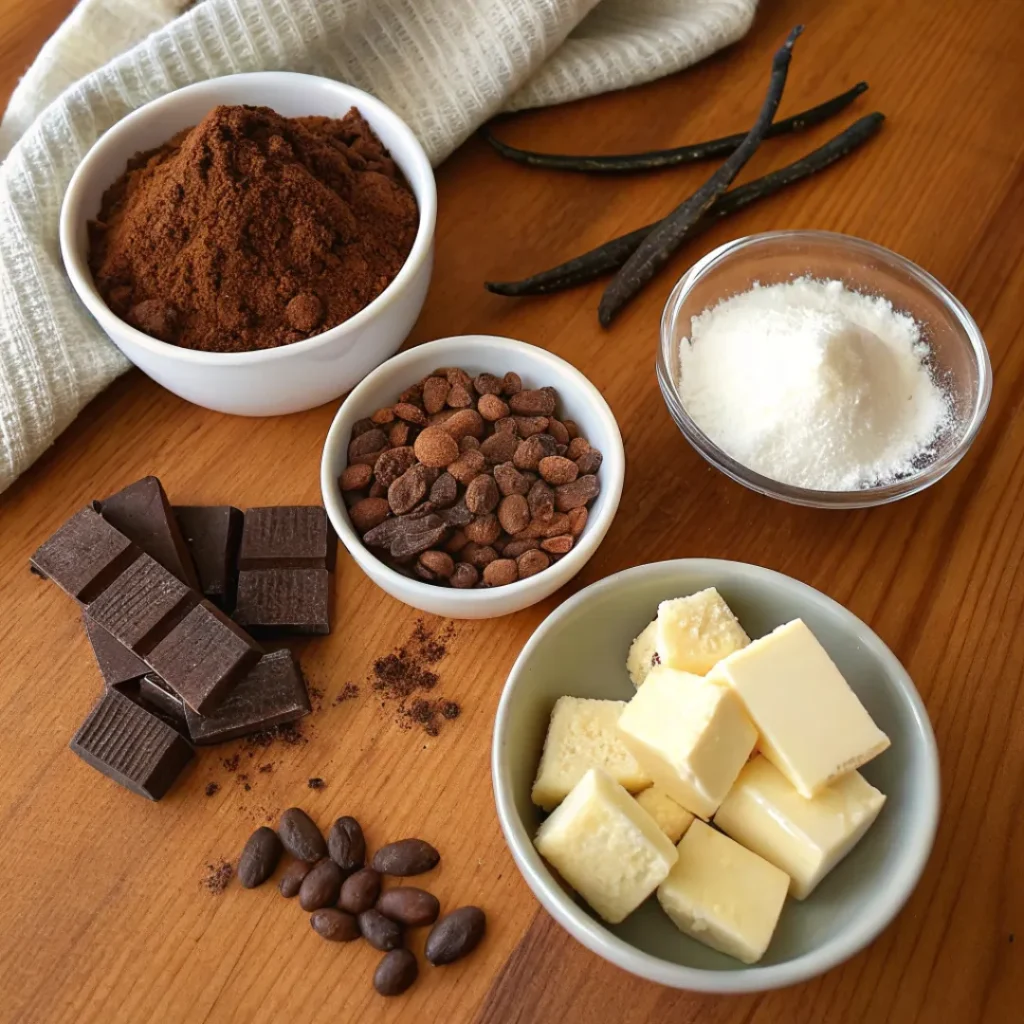
In homemade dark chocolate, however, you’re often skipping the refined sugar and cocoa butter. Instead, the percentage is based on how much cacao or cocoa powder you use in proportion to the total ingredient weight.
For a deeper breakdown on how chocolate makers calculate percentages, check out Theo Chocolate’s guide on understanding cocoa percentages—it explains the balance of cacao solids, butter, and sweeteners in every bar.
Understanding Cacao Ratios in Homemade Dark Chocolate
Let’s break it down using a basic homemade dark chocolate recipe:
- Coconut oil: 105g
- Honey: 85g
- Cacao powder: 118g
- Total weight: 308g
- Cacao content: 118g
To find the cacao percentage:
(118 ÷ 308) × 100 = ~38% cacao
So, this base recipe yields a 38% homemade dark chocolate—mild, creamy, and sweet. But what if you want something more intense?
A DIY Formula for 70% Dark Chocolate
To hit 70% cacao in your homemade dark chocolate, you’ll need to increase the cacao powder and reduce the sweetener and oil:
- Cacao powder: 140g
- Coconut oil: 40g
- Honey: 20g
- Total: 200g → (140 ÷ 200 = 70%)
This creates a much darker, richer chocolate—similar to high-end European bars—with less sweetness and more bitterness.
Need more ways to indulge? Try our Chocolate Lasagna recipe for a crowd-pleasing layered dessert loaded with chocolate flavor.
How to Adjust Percentages in Homemade Dark Chocolate Recipes
Here’s how to modify the strength and sweetness of your homemade dark chocolate:
- For 50–60%: Add more sweetener or oil to reduce bitterness.
- For 70–85%: Increase cacao content and cut down the honey or maple.
- For above 85%: Stick with pure cacao, a pinch of salt, and just a hint of sweetener.
If you’re new to dark chocolate, start around 50–60% cacao and gradually increase the intensity as your palate adjusts. The beauty of homemade dark chocolate is its flexibility—and the fact that it’s always free from preservatives and artificial additives.
Cost & Value: Homemade vs Store-Bought
Is It Cheaper to Make Your Own Chocolate?
Yes—making homemade dark chocolate is usually cheaper, especially when compared to high-quality, organic, or fair-trade bars. While there’s an upfront cost for ingredients like raw cacao and coconut oil, you’ll yield multiple batches for the same price as one or two premium bars.
Let’s do the math based on common 2025 prices:
| Ingredient | Quantity per Batch | Approx. Cost (USD) |
|---|---|---|
| Coconut oil | ½ cup (105g) | $1.20 |
| Raw cacao powder | 1 cup (118g) | $2.50 |
| Honey (or maple) | 4 tbsp (85g) | $1.00 |
| Total Cost | For ~200g batch | $4.70 |
That’s less than $2.50 per 100g, compared to $4–$7 per 100g for store-bought chocolate with clean ingredients.
Ingredient Costs Breakdown
Here’s a closer look at the value:
- Raw cacao powder: One 1 lb (454g) bag costs ~$9 and yields 4 batches
- Coconut oil: One 16 oz jar (~454g) costs ~$6 and gives you 4+ batches
- Honey: One 12 oz bottle (~340g) costs ~$5 and sweetens 4 batches or more
That means with one shopping trip, you can make 4–5 full bars of dark chocolate, customize them your way, and skip preservatives entirely.
Looking for more value-friendly desserts? Explore our Banana Chocolate Chip Cookies—made with pantry staples and perfect for baking on a budget.
Long-Term Savings vs Gourmet Bars
Gourmet dark chocolate bars can cost up to $10 or more in specialty stores. By comparison, making your own gives you:
- More volume for less money
- Total control over sweetness and ingredients
- The satisfaction of a DIY treat you can customize or gift
In the long run, if you’re someone who regularly buys chocolate, the homemade route saves money, reduces waste, and increases nutritional value.
Is It Worth Making Chocolate at Home?
Is It Worth It to Make Chocolate at Home?
Absolutely—making chocolate at home is 100% worth it, especially if you value ingredient quality, flavor control, and health. While it might not replace every bar you buy, homemade dark chocolate gives you full transparency over what goes into your food.
It’s also a creative, satisfying process. You’re not just melting and mixing—you’re building something tailored to your taste, your diet, and your lifestyle.
Here’s why most people say it’s worth it:
- You can control cacao percentage, sweetness, and texture
- You can make it dairy-free, sugar-free, or vegan
- It’s budget-friendly compared to premium brands
- You avoid preservatives, emulsifiers, and hidden oils
Curious about DIY-style treats? Don’t miss our Chocolate Chip Zucchini Bread for another wholesome dessert with a fun twist.
Customization, Dietary Benefits, and Freshness
Homemade chocolate lets you tailor the flavor to exactly what you want. Prefer your chocolate sweet and creamy? Add more honey and a splash of vanilla. Want it bold and bitter? Use extra cacao and no sweetener at all.
You can also add your favorite ingredients:
- Chopped nuts, sea salt, chili flakes
- Orange zest, dried berries, or espresso powder
- Protein powder, collagen, or adaptogens for functional desserts
And it’s always fresh—no waxy texture or chalky finish like cheap commercial chocolate. When it’s made from scratch, the difference in quality is clear.
Challenges to Consider
Of course, no DIY project is perfect. Keep these key points in mind:
- Temperature-sensitive: Coconut oil melts easily, so the chocolate may soften at room temperature
- Shorter shelf life: Without added preservatives, this should be consumed within 1 to 2 weeks
- Texture: Homemade chocolate doesn’t have the snap of tempered bars unless you add cocoa butter or temper the batch (optional)
Still, most people agree: the taste, nutrition, and creativity make it more than worth it.
Chocolate Prices in 2025: What’s Going On?
Why Is Chocolate So Expensive in 2025?
If you’ve noticed that your favorite chocolate bar now costs nearly double what it did two years ago—you’re not imagining things. In 2025, chocolate prices are at an all-time high, driven by a combination of global supply chain disruptions, extreme weather, and surging demand for premium cacao.
According to Forbes, cacao futures hit record highs due to poor harvests in West Africa—where most of the world’s cocoa is grown. Meanwhile, the push for more ethical sourcing and organic products has raised production costs.
What’s Driving the Cost Surge?
Here are the main reasons chocolate is more expensive now:
- Climate change: Droughts and disease have devastated cocoa crops in Ghana and Ivory Coast
- Inflation: Higher shipping and labor costs have driven up global food prices
- Sustainable sourcing: More brands are investing in fair trade, which increases retail pricing
- Consumer demand: Interest in dark, organic, and artisanal chocolates continues to rise
This means even mid-range bars that were $3.99 in 2022 can now cost $6–$9 in 2025—especially if they’re labeled as “clean” or “organic.”
Why Homemade Is a Smart Move in 2025
With just three simple ingredients—cacao powder, coconut oil, and honey—you can skip the price markup and still enjoy rich, antioxidant-packed chocolate.
Here’s what homemade offers in the face of rising costs:
- Predictable pricing – Buy in bulk and save
- No shrinkflation – You control the portion sizes
- More value – One batch yields several servings for less than a single store-bought bar
Looking for another cost-conscious dessert? Try our Old-Fashioned Baked Macaroni and Cheese—comfort food made affordably, just like this chocolate.
Creative Uses for Homemade Dark Chocolate
Moulds, Bars, Bark, and Beyond
One of the best parts about homemade dark chocolate is how versatile it is. With just one base recipe, you can create endless variations depending on how you pour and flavor it.
Here are a few popular ideas:
- Silicone molds: Create bite-sized hearts, coins, or cubes for easy snacking
- Chocolate bark: Pour chocolate onto a lined sheet pan, sprinkle with toppings (nuts, seeds, berries), then break into rustic pieces
- Mini bars: Use ice cube trays or chocolate bar molds for custom sizes
- Layered treats: Use it as a topping or swirl in brownies, cookies, or homemade granola
Want something fun and customizable? Try our Tropical Smoothie Bowl and top it with shaved homemade chocolate for a clean, crunchy twist.
Flavor Upgrades That Wow
Once you’ve mastered the base, try boosting your chocolate with these mix-ins:
- Sea salt flakes: Add after pouring for that sweet-salty balance
- Chopped almonds or pistachios: Toast first for deeper flavor
- Dried fruit: Cranberries, cherries, mango, or orange peel
- Spices: Cinnamon, cardamom, or chili powder for a gourmet kick
- Vanilla or peppermint extract: Add a few drops to the mix before pouring
These upgrades take your DIY chocolate from basic to boutique-quality—with none of the extra cost.
Gifting and Storing Ideas
Homemade dark chocolate makes a thoughtful and affordable gift. Wrap pieces in parchment and twine, place in mason jars, or use candy boxes for holidays and birthdays.
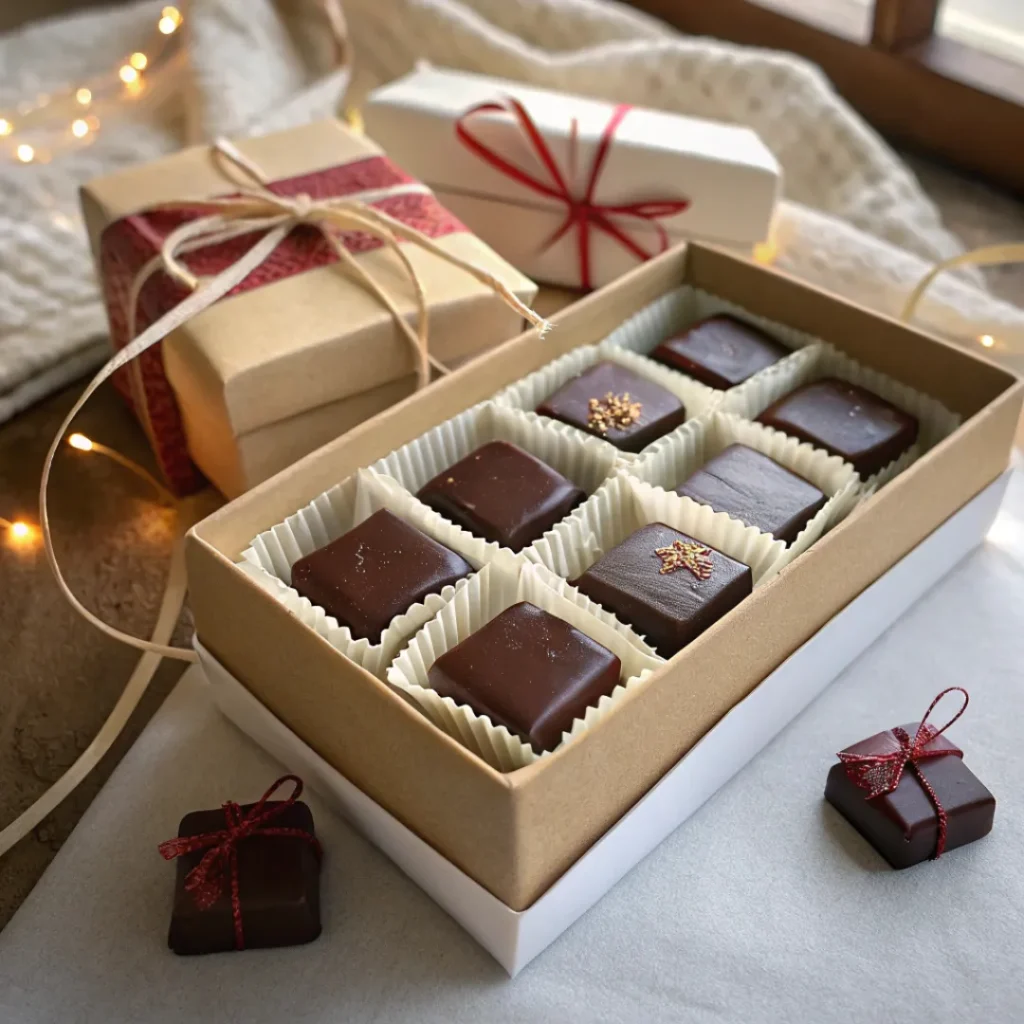
Storage Tips:
- Keep in an airtight container in the fridge or cool pantry
- Avoid direct sunlight and heat (coconut oil melts easily)
- Good for up to 2 weeks in the fridge, or longer if frozen
Looking for more homemade gift ideas? Check out our Carrot Cake Cookies—easy to bake, store, and share.
Frequently Asked Questions
Is homemade dark chocolate healthy?
Yes, homemade dark chocolate is healthy, especially when made with raw cacao powder, coconut oil, and natural sweeteners like honey or maple syrup. Unlike many store-bought versions, you’re in control of the sugar level and avoid preservatives, soy, and dairy. Plus, raw cacao is packed with antioxidants and magnesium, which support heart health and brain function.
How is 70% dark chocolate made?
70% dark chocolate means that 70% of the total weight comes from cacao components—cocoa powder, butter, or solids. In homemade versions, this is calculated by comparing the cacao powder to the total recipe weight. For example, to hit 70%, use more cacao powder and less oil or sweetener. It results in a deeper, richer chocolate with less sweetness.
Is it cheaper to make your own chocolate?
Yes—DIY chocolate is generally more cost-effective than buying premium dark chocolate bars. With bulk ingredients, you can produce several batches of chocolate for the cost of just one or two organic store-bought bars. Plus, you avoid paying extra for branding and packaging.
Is it worth it to make chocolate at home?
Definitely. Making homemade chocolate allows for total ingredient control, customization, and freshness. You can adjust the sweetness, create unique flavor combos, and skip unwanted additives. While it might not have the snap of tempered chocolate, the flavor and nutrition are unbeatable.
Conclusion
Homemade dark chocolate isn’t just a healthier alternative—it’s a simple way to take full control of what goes into your treats. With just a few real, whole ingredients, you can craft homemade dark chocolate that’s rich in antioxidants, customizable to your taste, and aligned with your dietary needs. Whether you’re cutting out refined sugar, sticking to a clean-eating lifestyle, or navigating 2025’s rising grocery prices, homemade dark chocolate offers a delicious, budget-friendly solution.
From choosing your ideal cacao percentage to experimenting with flavors, textures, and molds, making dark chocolate at home opens up endless possibilities. So why settle for waxy, processed bars when you can whip up your own homemade chocolate in just 10 minutes?
Print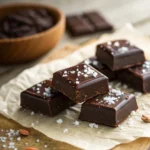
Homemade Dark Chocolate
- Total Time: 10 minutes
- Yield: 12 small squares 1x
Description
A rich and healthy homemade dark chocolate recipe made with just 3 clean ingredients—coconut oil, cacao powder, and honey. Perfect for snacking, gifting, or customizing with your favorite flavors.
Ingredients
½ cup coconut oil (105g)
4 tbsp honey or maple syrup (85g), adjust to taste
Pinch of sea salt
1 cup unsweetened cocoa powder or raw cacao powder (118g)
Instructions
1. Melt the coconut oil in a small saucepan over low heat.
2. Remove from heat and stir in the honey and sea salt until dissolved.
3. Whisk in the cacao powder until fully smooth with no lumps.
4. Pour the mixture into silicone molds or a parchment-lined baking pan.
5. Let cool at room temperature or chill in the fridge until fully set.
6. Once firm, remove from molds or cut into pieces and enjoy.
Notes
Use raw cacao for maximum antioxidants.
Store in a cool place or refrigerate for best texture.
Add flavors like sea salt, orange zest, or chili flakes for variation.
Will keep for 2 weeks refrigerated.
- Prep Time: 5 minutes
- Cook Time: 5 minutes
- Category: Dessert
- Method: No Bake
- Cuisine: Global
Nutrition
- Serving Size: 1 piece
- Calories: 110
- Sugar: 6g
- Sodium: 15mg
- Fat: 9g
- Saturated Fat: 8g
- Unsaturated Fat: 1g
- Trans Fat: 0g
- Carbohydrates: 8g
- Fiber: 2g
- Protein: 1g
- Cholesterol: 0mg

